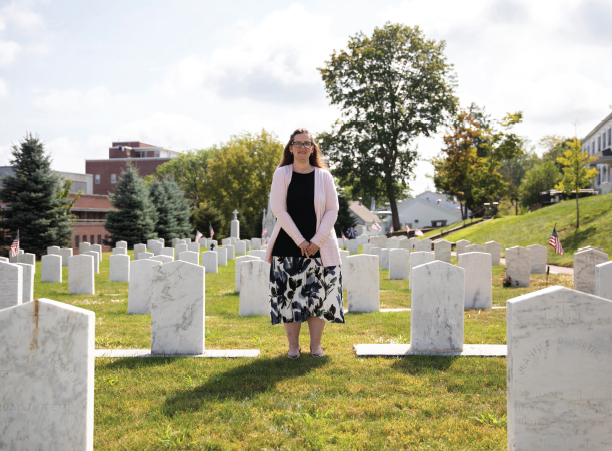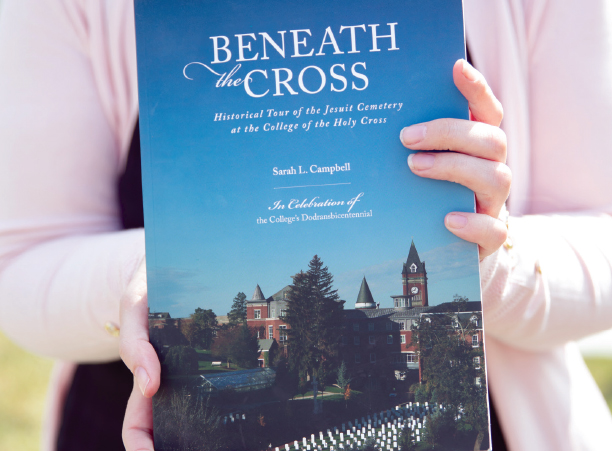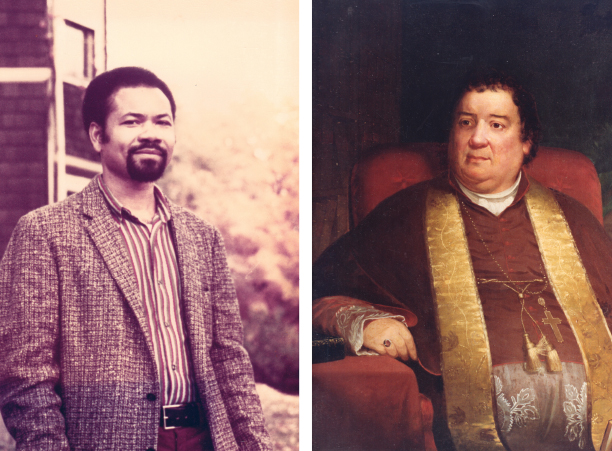
Hundreds walk by daily, but most would recognize only a handful of the names on the nearly 300 white stone markers at the Jesuit Cemetery. A new book seeks to rectify that, detailing the lives of those interred and, in the process, providing another look at Holy Cross history.
Published this summer, "Beneath the Cross" was written by Sarah Campbell, assistant archivist at the College's Archives and Special Collections, in celebration of Holy Cross' 175th anniversary.
"We wanted to provide readers with more information about the men who were buried within the cemetery, as well as the history of the College, through their stories," she says.
She didn't know it, but Campbell had been working on the book years before it was envisioned. Over time, she had been compiling information on some of the men buried in the cemetery with thoughts of creating a walking guide of the location, nestled between St. Joseph Memorial Chapel, Brooks Music Hall and Campion House.
"We got asked about [those interred] a lot, so I thought it would be nice to have a finding aid to the cemetery with the little information I gleaned," she says.
In 2018, Frank Vellaccio, senior vice president emeritus and special advisor to the offices of the president and advancement, asked the Archives staff if they had information about the Jesuits buried in the cemetery over the past 25 years; Campbell shared what she had compiled thus far. With the College's 175th anniversary approaching, Vellaccio saw the potential for something much larger than a walking guide — a comprehensive book with biographies and photos.
"I can't overemphasize what a great job Sarah did, the amount of work it took and the love and passion she brought to the task," he says. "It is great to have a good idea, but the real gift is to have someone able and willing to make that idea a reality."
Inside Extensive Research
The book is divided into seven chapters, each exploring a 25-year span of the College's history. Each chapter offers a timeline of key College events, as well as biographies of the men who were buried during each period.
Campbell says the backbone of her research came courtesy of one of the men buried in the cemetery, the late Rev. Anthony J. Kuzniewski, S.J., professor of history, who wrote the book "Thy Honored Name: A History of the College of the Holy Cross, 1843-1994."
"I couldn't have written this without Fr. K," she says. "He was very much on my mind throughout writing this, and I dearly wish I had been able to talk to him about it."
 Sarah Campbell holds her new book, "Beneath the Cross." Photo by Avanell Brock
Sarah Campbell holds her new book, "Beneath the Cross." Photo by Avanell BrockWriting a book instead of a walking guide meant hundreds of subjects to research, so Campbell also combed College Archives and the online Jesuit Archives at the University of St. Louis. Through the latter, she was able to access more than 100 years of obituaries printed in the Woodstock Letters, a publication produced via Woodstock College, a Jesuit seminary in Maryland.
"Those early obituaries were beautiful, incredibly rich in detail," Campbell says. "The way they spoke of them, you got a sense of who they were."
Campbell also searched internet archives, worked with the College's current Jesuit Community and even had a hand from her mother, Judy Campbell, a librarian and genealogist who researched Massachusetts Death Records.
Contrary to popular belief, not everyone buried in the cemetery was a member of the College's faculty or Jesuit Community. Prior to 1939, when a cemetery was established at the Campion Center Jesuit community in Weston, Massachusetts, Holy Cross was home to one of the only Jesuit cemeteries in the east. As a result, Jesuits living in the Boston area were buried on campus; after 1939, they were buried at the Campion Center and the Jesuit Cemetery on campus was nearly all Holy Cross-affiliated men. Those interred pre-1939 also include diocesan priests, priests from southern communities who visited for health reasons and died while on campus, Jesuit brothers and scholastics.
There is also one layman buried at the Jesuit Cemetery: Francis L. Miller Sr. Miller was the College's first bursar, worked on Mount St. James for 47 years and was a well-loved figure on campus. Upon Miller's death in 1961, then-College President Rev. Raymond J. Swords, S.J., reached out to family members of the Jesuits interred in the cemetery to see if any had objection to Miller's burial there. In the cemetery, each marker is identical, bearing a name, date of birth (Natus), date of death (Obiit) and entry into the order (Ingressus). Instead of the latter, Miller's reads: "Collegii Sanctae Crucis Amicus Devotus": Devoted Friend of the College of the Holy Cross.
Retrieving Information Lost to Time
Campbell's research yielded much about the men's careers, information that may have otherwise been lost to time, such as Rev. George A. King, S.J., who was the first U.S. Army chaplain to earn his Ph.D. on the GI Bill; Rev. Thomas J. Smith, S.J., who went on a 1936 National Geographic expedition to Russia to photograph the solar eclipse and was present at the 1959 atomic tests in Nevada; and Rev. Marian Balcells, S.J., a well-known scientist who did pioneering work in the field of solar physics — his obituary was published in acclaimed journals, such as "Nature."
"They all were amazing to find out about," Campbell says. Rev. Lionel P. Honoré, S.J., accomplished chef and gardener (left) and Holy Cross founder Bishop Benedict J. Fenwick.
Rev. Lionel P. Honoré, S.J., accomplished chef and gardener (left) and Holy Cross founder Bishop Benedict J. Fenwick.
Her work also yielded a considerable amount of details of their lives beyond the classroom or ministry, such as:
- Rev. William A. Carroll, S.J., a member of the classics department, loved entering contests. Over the years, he won a trip to Disneyland, a duo-console piano, a heating unit for a 10-room house, watches and a year's supply of ice cream and cat food.
- Rev. Lionel P. Honoré, S.J., a member of the modern languages department in the 1970s-1990s, was an accomplished chef, as well as an avid gardener who started his bulbs in the Jesuit Community's computer room.
- Kimball Hall namesake Rev. Charles Leo Kimball, S.J., was known as "the Roper" for his talent at convincing students to join the priesthood.
- Long before Rev. John D. Whitney, S.J., served as president of Georgetown University, he was a non-Catholic layman serving on a training ship for the New York Maritime College. Leaving Newport, R.I., the captain allowed a newlywed couple to hitch a ride back to New York. At one point in the voyage, the new bride dropped a book over the side of the boat, which the crew rescued via a lifeboat. Despite the crew's efforts, the woman left the book behind when she departed the ship. Intrigued by a now twice-abandoned book, Whitney discovered it was "The Invitation Heeded," a book given to those converting to Catholicism. Already impressed by the sermons given by the ship's chaplain, Whitney read the book and then sought out the chaplain, wishing to convert.
As part of her research, Campbell visited other college cemeteries, where she observed that the tombstones were an amalgam of shapes and sizes. However, at Holy Cross all markers are the same size (save for two, Bishop Benedict J. Fenwick, S.J., and his secretary, Rev. George Goodwin). She soon discovered the reason: All men were considered equal in the eyes of God.
"It didn't matter if you were a scholastic who hadn't been ordained yet, or a brother or the president of a college, you all had the same grave," she says.
"Beneath the Cross" can be ordered from the College Bookstore.
Written by Mary Cunningham '17 for the Fall 2019 issue of Holy Cross Magazine.
About Holy Cross Magazine Holy Cross Magazine (HCM) is the quarterly alumni publication of the College of the Holy Cross. The award-winning publication is mailed to alumni and friends of the College and includes intriguing profiles, make-you-think features, alumni news, exclusive photos and more. Visit magazine.holycross.edu/about to contact HCM, submit alumni class notes, milestones, or letters to the editor.

